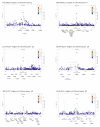Genome-wide association study in individuals of South Asian ancestry identifies six new type 2 diabetes susceptibility loci
- PMID: 21874001
- PMCID: PMC3773920
- DOI: 10.1038/ng.921
Genome-wide association study in individuals of South Asian ancestry identifies six new type 2 diabetes susceptibility loci
Abstract
We carried out a genome-wide association study of type-2 diabetes (T2D) in individuals of South Asian ancestry. Our discovery set included 5,561 individuals with T2D (cases) and 14,458 controls drawn from studies in London, Pakistan and Singapore. We identified 20 independent SNPs associated with T2D at P < 10(-4) for testing in a replication sample of 13,170 cases and 25,398 controls, also all of South Asian ancestry. In the combined analysis, we identified common genetic variants at six loci (GRB14, ST6GAL1, VPS26A, HMG20A, AP3S2 and HNF4A) newly associated with T2D (P = 4.1 × 10(-8) to P = 1.9 × 10(-11)). SNPs at GRB14 were also associated with insulin sensitivity (P = 5.0 × 10(-4)), and SNPs at ST6GAL1 and HNF4A were also associated with pancreatic beta-cell function (P = 0.02 and P = 0.001, respectively). Our findings provide additional insight into mechanisms underlying T2D and show the potential for new discovery from genetic association studies in South Asians, a population with increased susceptibility to T2D.
Figures



References
-
- Chambers JC, Obeid OA, Refsum H, et al. Plasma homocysteine concentrations and risk of coronary heart disease in UK Indian Asian and European men. Lancet. 2000;355(9203):523–527. - PubMed
-
- Ramachandran A, Ma RC, Snehalatha C. Diabetes in Asia. Lancet. 2010;375(9712):408–418. - PubMed
-
- Shaw JE, Sicree RA, Zimmet PZ. Global estimates of the prevalence of diabetes for 2010 and 2030. Diabetes Res Clin Pract. 2010;87(1):4–14. - PubMed
-
- McCarthy MI. Genomics, type 2 diabetes, and obesity. N Engl J Med. 2010;363:2339–50. - PubMed
Publication types
MeSH terms
Grants and funding
- G0801056/MRC_/Medical Research Council/United Kingdom
- SP/04/002/BHF_/British Heart Foundation/United Kingdom
- R01 DK082766/DK/NIDDK NIH HHS/United States
- 083270/Z/07/Z/WT_/Wellcome Trust/United Kingdom
- 079643/WT_/Wellcome Trust/United Kingdom
- 090532/WT_/Wellcome Trust/United Kingdom
- 070854/Z/03/Z/WT_/Wellcome Trust/United Kingdom
- DK-25446/DK/NIDDK NIH HHS/United States
- R01DK082766/DK/NIDDK NIH HHS/United States
- 084723/Z/08/Z/WT_/Wellcome Trust/United Kingdom
- G0700931/MRC_/Medical Research Council/United Kingdom
- G0601966/MRC_/Medical Research Council/United Kingdom
- KO1TW006087/TW/FIC NIH HHS/United States
- RG/08/014/24067/BHF_/British Heart Foundation/United Kingdom
- 080747/Z/06/Z/WT_/Wellcome Trust/United Kingdom
- RP-PG-0407-10371/DH_/Department of Health/United Kingdom
- K01 TW006087/TW/FIC NIH HHS/United States
LinkOut - more resources
Full Text Sources
Other Literature Sources
Molecular Biology Databases

